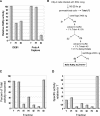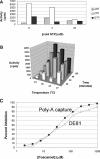Polyadenylation-dependent screening assay for respiratory syncytial virus RNA transcriptase activity and identification of an inhibitor
- PMID: 15356293
- PMCID: PMC519107
- DOI: 10.1093/nar/gkh809
Polyadenylation-dependent screening assay for respiratory syncytial virus RNA transcriptase activity and identification of an inhibitor
Abstract
RNA-dependent RNA polymerase from respiratory syncytial virus (RSV) is a multi-subunit ribonucleoprotein (RNP) complex that, in addition to synthesizing the full 15 222 nt viral genomic RNA, is able to synthesize all 10 viral mRNAs. We have prepared crude RNP from RSV-infected HEp-2 cells, based on a method previously used for Newcastle disease virus, and established a novel polyadenylation-dependent capture [poly(A) capture] assay to screen for potential inhibitors of RSV transcriptase activity. In this homogeneous assay, radiolabeled full-length polyadenylated mRNAs produced by the viral RNP are detected through capture on immobilized biotinylated oligo(dT) in a 96-well streptavidin-coated FlashPlate. Possible inhibitors identified with this assay could interfere at any step required for the production of complete RSV mRNAs, including transcription, polyadenylation and, potentially, co-transcriptional guanylylation. A specific inhibitor of RSV transcriptase with antiviral activity was identified through screening of this assay.
Figures





Similar articles
-
Inhibitors of respiratory syncytial virus replication target cotranscriptional mRNA guanylylation by viral RNA-dependent RNA polymerase.J Virol. 2005 Oct;79(20):13105-15. doi: 10.1128/JVI.79.20.13105-13115.2005. J Virol. 2005. PMID: 16189012 Free PMC article.
-
Respiratory Syncytial Virus Inhibitor AZ-27 Differentially Inhibits Different Polymerase Activities at the Promoter.J Virol. 2015 Aug;89(15):7786-98. doi: 10.1128/JVI.00530-15. Epub 2015 May 20. J Virol. 2015. PMID: 25995255 Free PMC article.
-
Expression of RNA virus proteins by RNA polymerase II dependent expression plasmids is hindered at multiple steps.Virol J. 2007 Jun 5;4:51. doi: 10.1186/1743-422X-4-51. Virol J. 2007. PMID: 17550613 Free PMC article.
-
Discovery of a potent respiratory syncytial virus RNA polymerase inhibitor.Bioorg Med Chem Lett. 2013 Dec 15;23(24):6789-93. doi: 10.1016/j.bmcl.2013.10.018. Epub 2013 Oct 16. Bioorg Med Chem Lett. 2013. PMID: 24211022
-
Comparison of a real-time reverse transcriptase PCR assay and a culture technique for quantitative assessment of viral load in children naturally infected with respiratory syncytial virus.J Clin Microbiol. 2005 May;43(5):2356-62. doi: 10.1128/JCM.43.5.2356-2362.2005. J Clin Microbiol. 2005. PMID: 15872266 Free PMC article.
Cited by
-
Organization, Function, and Therapeutic Targeting of the Morbillivirus RNA-Dependent RNA Polymerase Complex.Viruses. 2016 Sep 10;8(9):251. doi: 10.3390/v8090251. Viruses. 2016. PMID: 27626440 Free PMC article. Review.
-
Orally efficacious broad-spectrum allosteric inhibitor of paramyxovirus polymerase.Nat Microbiol. 2020 Oct;5(10):1232-1246. doi: 10.1038/s41564-020-0752-7. Epub 2020 Jul 13. Nat Microbiol. 2020. PMID: 32661315 Free PMC article.
-
Mechanism of action for respiratory syncytial virus inhibitor RSV604.Antimicrob Agents Chemother. 2015 Feb;59(2):1080-7. doi: 10.1128/AAC.04119-14. Epub 2014 Dec 1. Antimicrob Agents Chemother. 2015. PMID: 25451060 Free PMC article.
-
Cyclophilin A Inhibits Human Respiratory Syncytial Virus (RSV) Replication by Binding to RSV-N through Its PPIase Activity.J Virol. 2021 Jul 12;95(15):e0056321. doi: 10.1128/JVI.00563-21. Epub 2021 Jul 12. J Virol. 2021. PMID: 34011546 Free PMC article.
-
Biochemistry of the Respiratory Syncytial Virus L Protein Embedding RNA Polymerase and Capping Activities.Viruses. 2023 Jan 25;15(2):341. doi: 10.3390/v15020341. Viruses. 2023. PMID: 36851554 Free PMC article. Review.
References
-
- Collins P.L., Chanock,R.M. and Murphy,B.R. (2001) Respiratory syncytial virus. In Knipe,D.M.H.P.M. (ed.), Fields Virology. Lippincott, Williams & Wilkens, NY, pp. 1443–1485.
-
- Hall C.B., McBride,J.T., Walsh,E.E., Bell,D.M., Gala,C.L., Hildreth,S., Ten Eyck,L.G. and Hall,W.J. (1983) Aerosolized ribavirin treatment of infants with respiratory syncytial viral infection. A randomized double-blind study. N. Engl. J. Med., 308, 1443–1447. - PubMed
-
- Prince G.A. (2001) An update on respiratory syncytial virus antiviral agents. Expert. Opin. Investig. Drugs, 10, 297–308. - PubMed
-
- Groothuis J.R. and Nishida,H. (2002) Prevention of respiratory syncytial virus infections in high-risk infants by monoclonal antibody (palivizumab). Pediatr. Int., 44, 235–241. - PubMed
-
- Prince A.M. and Jacobs,R.F. (2001) Prevention of respiratory syncytial virus infection in high risk infants. J. Ark. Med. Soc., 98, 115–118. - PubMed
Publication types
MeSH terms
Substances
LinkOut - more resources
Full Text Sources
Other Literature Sources
Research Materials

